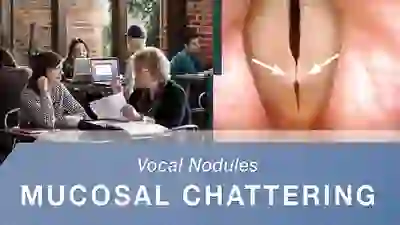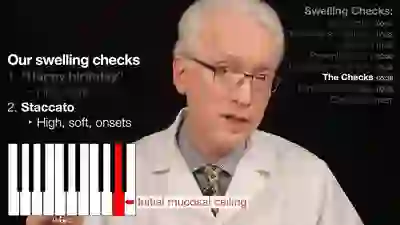Mucosal Chatter
Mucosal chatter is an audible phenomenon of injured vocal cord vibration. It is commonly heard in the softly-sung upper voice of persons with nodules, polyps, etc.
Hoarseness or roughness are broad and nonspecific descriptors useful only for severe injuries. Small injuries that are nevertheless impairing the singing range may leave the speaking voice sounding normal. I suppose “hoarseness of singing range” could be used, but again, that would be an unsophisticated and basic description of vocal phenomenology.
Audio Examples
How to Diagnose
To hear more useful phenomena of injury, we elicit and thereby investigate the upper range of singing (even in nonsingers) because high, soft singing makes the phenomenology apparent. This is why we have described “vocal cord swelling checks” and created a video to teach how to elicit them, and also how to evaluate and communicate the phenomenology that results (See also Integrative Diagnostic Model).
Symptoms
In particular, delays of phonatory onset (“onset delays”) above approximately C5 (523 Hz) may indicate mucosal injury even when speaking voice sounds normal. Also heard is air-wasting, where there is a “scratchiness” to the excess airflow. Segmental vibration is also a common audible phenomenon of a mucosal disorder can also be easily taught and recognized.
Vocal cord mucosal chatter adds an extremely rapid “shudder” on top of the pitch of the voice. I have used “chatter” rather than “shudder” because the latter suggests a lower frequency than the former. It could be called a very fine-grained diplophonia…but typical diplophonia, caused by independent vibrating segments, is a much grosser vocal phenomenon.
While chatter is more subtle, once it is pointed out and taught briefly, most people can easily distinguish between onset delays, diplophonia, segmental vibration, the transient “squeaking” of a micro-segmental vibration, the crackling sound of mucus dancing on the vocal cords, and “chatter.” Those who master recognition of these phenomena can easily communicate them to colleagues.
For our purposes, let me stress again that the above phenomena—and chatter in particular—do not happen in the normal larynx, where vocal cord margins match perfectly and the mucosa oscillates normally. When heard—even in the person with a normal speaking voice—the examiner can strongly suspect a mucosal abnormality even before examining the vocal cords. In fact, where these phenomena are heard and initial examination looks normal, it would be a good idea to “look harder.”
Share this article

Vocal Cord Nodules – What Do They Sound Like?
In this video, Dr. Bastian makes extensive use of elicitation with his own voice in order to hear the “vocal phenomenology” of a voice under evaluation. He has named one phenomenon he has not heard described elsewhere as mucosal chatter.

Listen to Vocal Cords Chatter!
Mucosal chatter is an audible phenomenon of injured vocal cord vibration. It is commonly heard in the softly-sung upper voice of persons with nodules, polyps, etc.

Vocal Cord Swelling Checks
A Simple Way to Detect the Early Signs of Vocal Injury
Vocal cord swelling checks can help prevent a chronic vocal injury. The swelling checks, which are a pair of short, simple vocal exercises, help you to monitor the health of your vocal cord mucosa and detect the presence of any possible swelling, which could be the beginning of a potentially more serious vocal cord injury.
By performing these checks twice a day every day, you can hopefully respond quickly to any warning signs and avoid the need for treatment down the road.